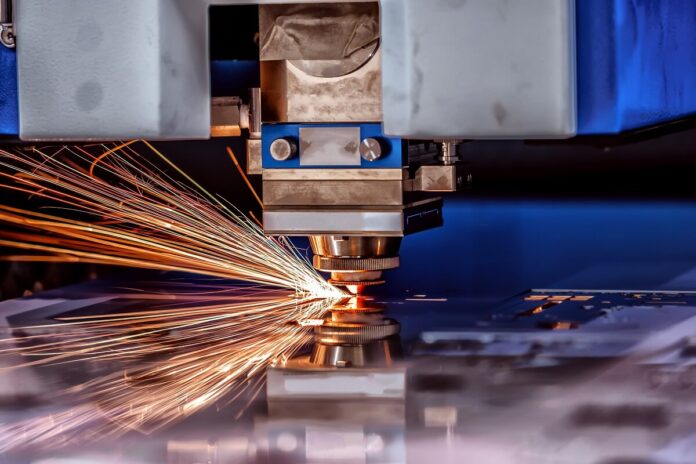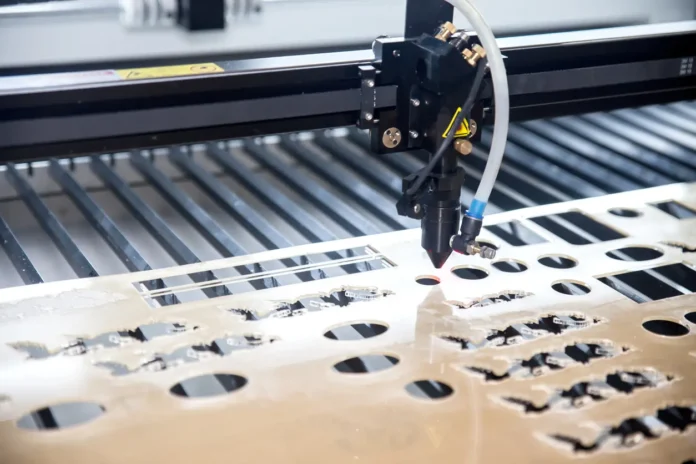
Have you ever seen a metal laser cutter at work? If you haven’t, then you’re missing out. Metal cutters are powerful and versatile tools that can cut through almost anything. They are incredibly precise, they’re quick, and they can even be used to create intricate patterns and designs.
No matter the material or the thickness, a metal laser cutter can be used to cut through it in no time. It can be used to cut steel, aluminum, copper, titanium, brass, stainless steel – even acrylic – with ease and accuracy. And because it uses lasers instead of blades or cutting tools that vibrate or spin, there is virtually no risk of over-cutting or damaging the material being worked on.
In this article, we’ll explore how metal cutting works and what makes it such a valuable tool for engineers and fabricators around the world.
What Is a Metal Laser Cutter?

A metal laser cutter is a machine that uses a laser beam to cut through various materials. It works by focusing a high-powered beam of light onto an object, which cuts the material along a programmed path. The laser technology is very precise and can be used to cut intricate shapes and patterns accurately. This makes it ideal for cutting intricate detail in metal objects.
The great advantage of laser cutting is its speed. It’s much faster than traditional methods such as sawing or machining, and the accuracy is much higher, too. Plus, because the laser only cuts where it’s supposed to cut, there’s minimal waste of material—a major benefit if you’re trying to save costs or if you’re looking for highly accurate results.
In addition, laser cutting produces a smoother edge than traditional methods, so there’s no need for additional finishing work. The result is a clean-looking product that requires less post-processing. This makes cutting an attractive option for those who want to quickly produce highly detailed pieces with minimal post-processing work or expenses.
How Does a Metal Laser Cutter Work?
When you use a metal cutter, the laser beam is focused into a fine spot that is capable of cutting through the metal. The beam is generated by a carbon dioxide gas that can produce a wavelength of 10.6 microns. This allows the laser to generate enough thermal energy to melt and vaporize the metal quickly.
To cut through metal with a cutter, the machine must be aligned to an exact position and have enough power behind it to produce the desired results. The power of the beam must be tightly focused in order for it to be able to cut through metal.
The main advantage of using a metal laser cutter is that it does not involve any physical contact between the cutter and the material being cut. This means that there are no risks of any wear and tear on your tools or in the material being cut. Additionally, since there is no physical contact, there are no sparks generated while cutting which makes it a much safer option than other traditional cutting methods such as ox fuel cutting or plasma arc cutting.
What Materials Can Be Cut by a Metal Laser Cutter?

A metal laser cutter is a tool that can cut through many materials with precision and ease. Different materials require different settings and pre-planning in order to get the best results, but metal cutters can work with a variety of metals, plastics, and many other materials.
Metals
Metals can be difficult to cut with traditional methods, but metal cutters can cut through even tough metals such as steel, stainless steel, titanium, aluminum, and brass.
Plastics
Plastics also benefit from the speed and accuracy of laser cutting. Examples of plastics that are easily cut with a include polyurethane (PU), acrylic (PMMA), polyvinyl chloride (PVC), polyethylene (PE), and polypropylene (PP). In any case, you must be careful with plastic materials!
Other Materials
The list doesn’t stop there – wood, rubber, paperboard, foam board, and even glass can all be accurately cut using a metal cutter. The precise nature of the laser beam allows for intricate shapes or patterns to be completed in minutes.
Benefits of Working with a Metal Laser Cutter
The metal laser cutter offers many advantages over other cutting technologies. It’s precise, efficient, and produces minimal wastage.
Precision
The use of a focused beam cuts through metal with levels of accuracy that can’t be achieved through traditional methods. This means that components produced with a cutter can fit together snugly, making less room for error and eliminating the need for additional machining.
Efficiency
Laser cutting is much faster than mechanical cutting or grinding methods – the beam can travel up to 10 meters per second in some cases, allowing projects to be completed quickly without losing the quality of the finished product. This makes it ideal for large-scale production runs.
Minimal Wastage
The laser cutter creates very minimal waste material, as it only removes what needs to be removed in order to create a finished product. There is virtually no need to drill holes or smooth down a surface after cutting, saving time and money on post-processing operations like deburring or sandblasting.
The Types of Lasers Used in a Metal Laser Cutter

Metal cutters use a variety of to produce precise, intricate cuts. The type of laser used depends on the material being cut and its thickness. The most common types used in a metal cutter are carbon dioxide (CO2) lasers, neodymium (Nd)YAG lasers, and fiber lasers.
Carbon Dioxide Lasers
CO2 lasers are the most common type of laser used for cutting metals. They can be used to cut materials up to 13 mm thick. This type produces a beam that is highly effective at cutting metals but not as precise as other types. However, they are better suited for cutting thicker materials due to their higher power output.
Neodymium YAG Lasers
NdYAG lasers are more precise than CO2 lasers and capable of producing cleaner edges. They can cut materials up to 3 mm thick and provide a higher-quality surface finish than CO2 lasers. NdYAG lasers also have a longer pulse duration compared to CO2, which results in better heat control during the cutting process.
Fiber Lasers
Fiber lasers are the most recent development in metal cutting technology and the fastest type available today. These types of lasers can cut through thin sheet metal (up to 1mm) with a high degree of accuracy and precision. However, their power output is not sufficient for thicker material, which limits their applications for some projects.
The Process of Using a Metal Laser Cutter
Using a metal cutter is the process of using this technology to cut through metals, including steel, aluminum, and titanium. The process relies on a high-powered laser beam that is typically generated by CO2 gas or neodymium glass.
Laser Technology
This technology used by the metal cutter allows for precise cutting with minimal waste. It works by focusing the beam onto a piece of metal, heating it up to the point where it burns and melts away in defined shapes and patterns. This results in clean cuts with minimal to no distortion.
Process Steps
The process of using a metal laser cutter involves several steps:
- Preparing the materials for cutting, which includes loading them onto the bed of the machine
- Programming the machine
- Using its computerized guidance system to direct the laser beam to make precise cuts
- Testing and finishing up with quality assurance checks
- Unloading materials from the machine after cutting is complete
This process allows you to cut through metals quickly and accurately while minimizing waste—an invaluable asset when dealing with costly materials like titanium or steel!
Conclusion
Metal cutters are an invaluable tool for any workshop, offering an incredibly precise and efficient way to cut through any material, quickly and easily. Whether you’re crafting small components or large-scale projects, a metal cutter makes it possible to create complex geometries with minimal difficulty. Additionally, the lack of contact between the material and the cutting head makes cutters a much more efficient option when compared to traditional cutting methods.
For anyone looking to up their cutting game, metal cutters are the way to go. They offer incredible accuracy, rapid speed, and the ability to cut through any material with ease. You can find a variety of metal cutters here. Whether you need a small part cut or a large-scale project completed, a metal cutter makes it possible for you to get the job done the right way.











